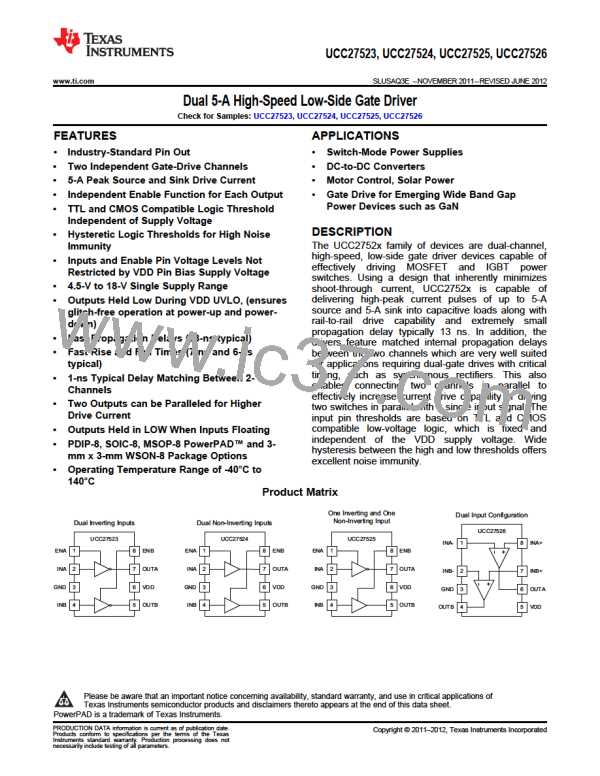UCC27523, UCC27524, UCC27525, UCC27526
SLUSAQ3E –NOVEMBER 2011–REVISED JUNE 2012
www.ti.com
The switching load presented by a power MOSFET can be converted to an equivalent capacitance by examining
the gate charge required to switch the device. This gate charge includes the effects of the input capacitance plus
the added charge needed to swing the drain voltage of the power device as it switches between the ON and OFF
states. Most manufacturers provide specifications that provide the typical and maximum gate charge, in nC, to
switch the device under specified conditions. Using the gate charge Qg, one can determine the power that must
be dissipated when charging a capacitor. This is done by using the equivalence Qg = CLOADVDD to provide the
following equation for power:
2
LOAD DD SW
P
= C
V
f
= Q V f
g DD SW
G
(4)
Assuming that UCC2752x is driving power MOSFET with 60 nC of gate charge (Qg = 60 nC at VDD = 12 V) on
each output, the gate charge related power loss can be calculated as:
P
= 2x60nC´12V ´300kHz = 0.432W
G
(5)
This power PG is dissipated in the resistive elements of the circuit when the MOSFET is being turned-on or off.
Half of the total power is dissipated when the load capacitor is charged during turn-on, and the other half is
dissipated when the load capacitor is discharged during turn-off. When no external gate resistor is employed
between the driver and MOSFET/IGBT, this power is completely dissipated inside the driver package. With the
use of external gate drive resistors, the power dissipation is shared between the internal resistance of driver and
external gate resistor in accordance to the ratio of the resistances (more power dissipated in the higher
resistance component). Based on this simplified analysis, the driver power dissipation during switching is
calculated as follows:
æ
ç
è
ö
÷
ø
R
R
ON
OFF
P
= Q ´ VDD´ f ´
SW
+
SW
G
R
+ R
R
+ R
ON GATE
OFF
GATE
(6)
where ROFF = ROL and RON (effective resistance of pull-up structure) = 1.5 x ROL
.
In addition to the above gate charge related power dissipation, additional dissipation in the driver is related to the
power associated with the quiescent bias current consumed by the device to bias all internal circuits such as
input stage (with pull-up and pull-down resistors), enable, and UVLO sections. Referring to the Figure 11 it can
be seen that the quiescent current is less than 0.6 mA even in the highest case. The quiescent power dissipation
can be simply calculated as:
P
= I
V
Q
DD DD
(7)
Assuming , IDD = 6 mA, the power loss is:
= 0.6 mA ´12V = 7.2mW
P
Q
(8)
Clearly, this is insignificant compared to gate charge related power dissipation calculated earlier.
With a 12-V supply, the bias current can be estimated as follows, with an additional 0.6-mA overhead for the
quiescent consumption:
P
0.432 W
G
I
~
=
= 0.036 A
DD
V
12 V
DD
(9)
24
Submit Documentation Feedback
Copyright © 2011–2012, Texas Instruments Incorporated
Product Folder Link(s): UCC27523, UCC27524, UCC27525, UCC27526

 TI [ TEXAS INSTRUMENTS ]
TI [ TEXAS INSTRUMENTS ]